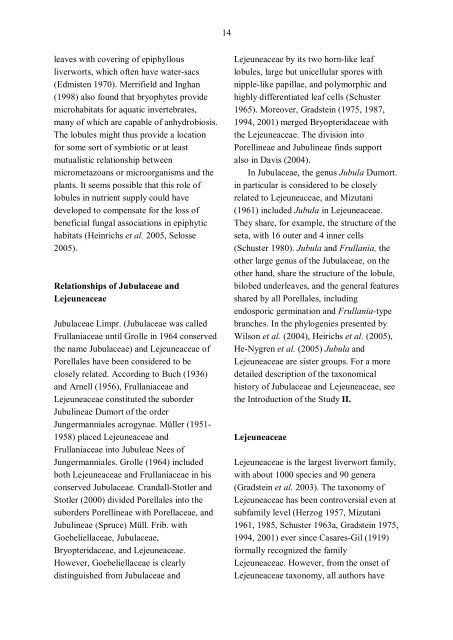Evolutionary relationships of liverworts with a special focus ... - Doria
Evolutionary relationships of liverworts with a special focus ... - Doria
Evolutionary relationships of liverworts with a special focus ... - Doria
You also want an ePaper? Increase the reach of your titles
YUMPU automatically turns print PDFs into web optimized ePapers that Google loves.
14<br />
leaves <strong>with</strong> covering <strong>of</strong> epiphyllous<br />
<strong>liverworts</strong>, which <strong>of</strong>ten have water-sacs<br />
(Edmisten 1970). Merrifield and Inghan<br />
(1998) also found that bryophytes provide<br />
microhabitats for aquatic invertebrates,<br />
many <strong>of</strong> which are capable <strong>of</strong> anhydrobiosis.<br />
The lobules might thus provide a location<br />
for some sort <strong>of</strong> symbiotic or at least<br />
mutualistic relationship between<br />
micrometazoans or microorganisms and the<br />
plants. It seems possible that this role <strong>of</strong><br />
lobules in nutrient supply could have<br />
developed to compensate for the loss <strong>of</strong><br />
beneficial fungal associations in epiphytic<br />
habitats (Heinrichs et al. 2005, Selosse<br />
2005).<br />
Relationships <strong>of</strong> Jubulaceae and<br />
Lejeuneaceae<br />
Jubulaceae Limpr. (Jubulaceae was called<br />
Frullaniaceae until Grolle in 1964 conserved<br />
the name Jubulaceae) and Lejeuneaceae <strong>of</strong><br />
Porellales have been considered to be<br />
closely related. According to Buch (1936)<br />
and Arnell (1956), Frullaniaceae and<br />
Lejeuneaceae constituted the suborder<br />
Jubulineae Dumort <strong>of</strong> the order<br />
Jungermanniales acrogynae. Müller (1951-<br />
1958) placed Lejeuneaceae and<br />
Frullaniaceae into Jubuleae Nees <strong>of</strong><br />
Jungermanniales. Grolle (1964) included<br />
both Lejeuneaceae and Frullaniaceae in his<br />
conserved Jubulaceae. Crandall-Stotler and<br />
Stotler (2000) divided Porellales into the<br />
suborders Porellineae <strong>with</strong> Porellaceae, and<br />
Jubulineae (Spruce) Müll. Frib. <strong>with</strong><br />
Goebeliellaceae, Jubulaceae,<br />
Bryopteridaceae, and Lejeuneaceae.<br />
However, Goebeliellaceae is clearly<br />
distinguished from Jubulaceae and<br />
Lejeuneaceae by its two horn-like leaf<br />
lobules, large but unicellular spores <strong>with</strong><br />
nipple-like papillae, and polymorphic and<br />
highly differentiated leaf cells (Schuster<br />
1965). Moreover, Gradstein (1975, 1987,<br />
1994, 2001) merged Bryopteridaceae <strong>with</strong><br />
the Lejeuneaceae. The division into<br />
Porellineae and Jubulineae finds support<br />
also in Davis (2004).<br />
In Jubulaceae, the genus Jubula Dumort.<br />
in particular is considered to be closely<br />
related to Lejeuneaceae, and Mizutani<br />
(1961) included Jubula in Lejeuneaceae.<br />
They share, for example, the structure <strong>of</strong> the<br />
seta, <strong>with</strong> 16 outer and 4 inner cells<br />
(Schuster 1980). Jubula and Frullania, the<br />
other large genus <strong>of</strong> the Jubulaceae, on the<br />
other hand, share the structure <strong>of</strong> the lobule,<br />
bilobed underleaves, and the general features<br />
shared by all Porellales, including<br />
endosporic germination and Frullania-type<br />
branches. In the phylogenies presented by<br />
Wilson et al. (2004), Heirichs et al. (2005),<br />
He-Nygren et al. (2005) Jubula and<br />
Lejeuneaceae are sister groups. For a more<br />
detailed description <strong>of</strong> the taxonomical<br />
history <strong>of</strong> Jubulaceae and Lejeuneaceae, see<br />
the Introduction <strong>of</strong> the Study II.<br />
Lejeuneaceae<br />
Lejeuneaceae is the largest liverwort family,<br />
<strong>with</strong> about 1000 species and 90 genera<br />
(Gradstein et al. 2003). The taxonomy <strong>of</strong><br />
Lejeuneaceae has been controversial even at<br />
subfamily level (Herzog 1957, Mizutani<br />
1961, 1985, Schuster 1963a, Gradstein 1975,<br />
1994, 2001) ever since Casares-Gil (1919)<br />
formally recognized the family<br />
Lejeuneaceae. However, from the onset <strong>of</strong><br />
Lejeuneaceae taxonomy, all authors have
















